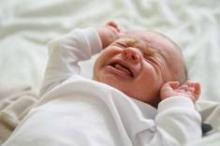Children and adolescents who presented to the emergency department with migraine headache were 6 times more likely to have a history of colic during infancy than were those who presented for other reasons, according to a report in the April 17 issue of JAMA.
In contrast, children and adolescents who presented to the ED with tension-type headache showed no increase in the likelihood that they had experienced infantile colic. This confirms the specificity of the association between migraine – not other types of headache – and colic, said Dr. Silvia Romanello of the department of pediatric emergency care and the pediatric migraine and neurovascular diseases unit, Robert Debré Hospital, Paris, and her associates.
Researchers and clinicians have long suspected an association between the two pain syndromes of colic and migraine, but such a link has not been well studied. Dr. Romanello and her colleagues at three tertiary-care hospitals in France and Italy examined the association in a case-control study involving 328 pediatric patients and 471 controls.
Subjects were aged 6-18 years and presented to EDs with primary headaches during a 3-month study period. A total of 208 were diagnosed by a pediatric neurologist as having primary migraine (142 without aura and 66 with aura), and 120 were diagnosed as having tension-type headache. The control subjects were patients of the same age who presented during the same period with minor trauma.
Patients with recurrent headaches were excluded from the study.
The medical records of all the study subjects were reviewed for a diagnosis of infantile colic. Parent questionnaires confirmed this history in every case.
A total of 72.6% of the patients with primary migraine had a history of infantile colic. The prevalence of colic was similarly high between those who had migraine with aura (69.7%) and those who had migraine without aura (73.9%).
In contrast, only 35% of the patients with tension-type headache had a history of infantile colic. This prevalence was similar to that in the control group (26.5%), the investigators said (JAMA 2013;309:1607-12).
In a further statistical analysis of the data, the association between infantile colic and migraine was highly significant, with an odds ratio of 6.61. No association was seen between infantile colic and tension-type headache or infantile colic and minor trauma.
A subgroup analysis showed that the association between infantile colic and migraine with aura was highly significant, with an OR of 5.73, as was the association between infantile colic and migraine without aura, which had an OR of 7.01. This finding indicates that the two pain disorders, colic and migraine, share a common pathophysiology, Dr. Romanello and her associates said.
Given that diagnosing headache in children can be challenging, another subgroup analysis was performed to explore any possible age-related bias in diagnosis. The results confirmed those of the main study: The association between migraine and infantile colic remained highly significant in both children aged 6-12 years and adolescents aged 13-18 years.
This study was not designed to explore the possible reasons for the strong association between migraine and colic. However, the investigators noted that colic might result from a sensitization of the perivascular nerve terminals in the gut, much as migraine results from a similar process in the brain.
Another possibility is that "molecules known to be involved in the modulation of sensory activity, such as calcitonin-gene-related peptide (CGRP)," which is released during migraine episodes, also may be involved in modulation of abdominal pain "by inducing the neurogenic inflammation of sensory neurons in the gut." If so, drugs that are CGRP antagonists, which are effective in pain management, may be found helpful for both colic and migraine.
In addition, triptans have proved extremely effective against acute attacks of both migraine and abdominal migraine, and eventually may be found useful for infantile colic. However, much more study is needed before such treatment can be considered. "It is currently difficult to imagine that clinical trials will be conducted with such off-label drugs for the treatment of a benign condition such as infantile colic," even though the condition clearly causes pain in infants and significant stress in parents, Dr. Romanello and her associates said.
No financial conflicts of interest were reported.


